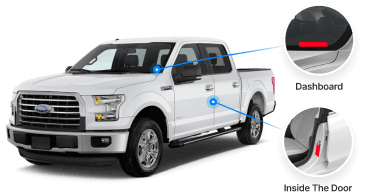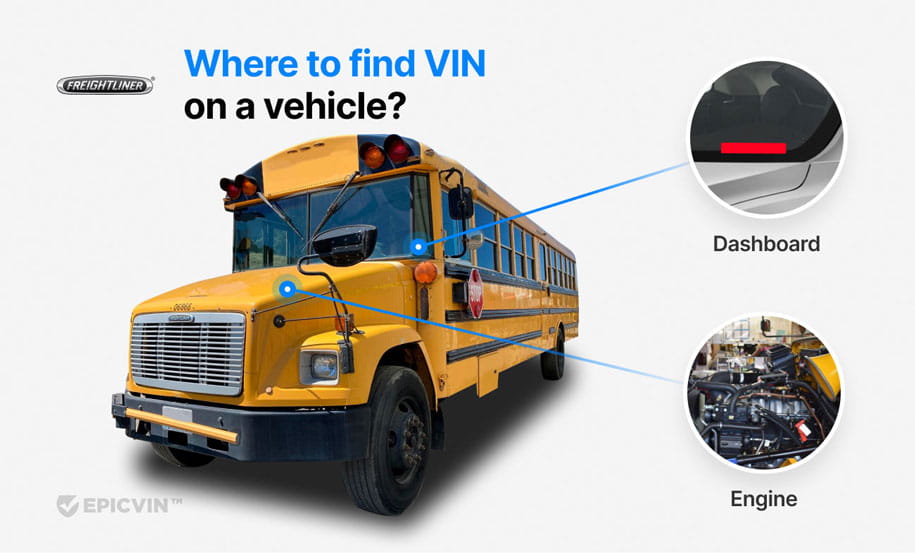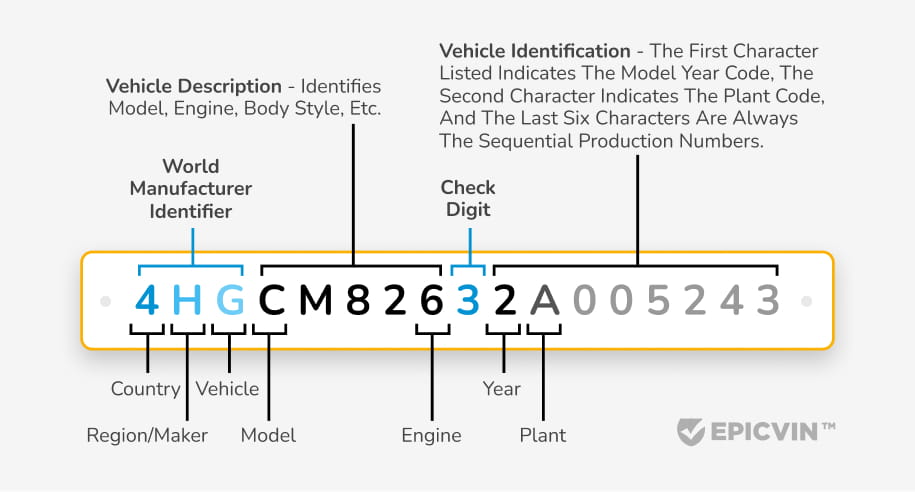
How to Read a VIN Number Like a Pro
From understanding the VIN number breakdown to uncovering a vehicle’s history,...
Read more
Check vehicle information with Freightliner VIN
Looking for the VIN?
Here is there you’ll find it:

Freightliner started as a way for Consolidated Freightways to get around strict vehicle length laws. By building the cab over the engine, the carrier could use longer trailers, increasing cargo capacity while still meeting regulations. Freightliner started selling trucks to other companies in the 1950s, and by the 1970s, it was a separate company from CF. Daimler-Benz bought Freightliner in 1981, putting it in control of their North American commercial vehicle divisions. From there, they acquired Oshkosh, American LaFrance, Thomas Built, Western Star, Detroit Diesel and Ford’s heavy duty truck division. By consolidating these operations, they have a presence in nearly every commercial truck segment, including chassis cabs for RVs, school buses, fire trucks and both medium and heavy-duty tractors. They even sold Mercedes-Benz Sprinter vans through their dealer network in the 2000s.
Do you need an affordable work truck? Would a used Sprinter be perfect for an overland conversion? Whether you’re looking at a cargo van or a Class 8 semi, visit EpicVIN before you buy. By using a VIN check, you can get the vehicle’s configuration information, including the engine and vehicle class. This makes finding the right truck a whole lot simpler. Worried you might buy a lemon? When you order a VIN report from us, you’ll get accident reports, title changes and other useful information about the truck’s history. That way, you can be confident you’re buying the right Freightliner for you.
When it comes to medium and heavy-duty trucks, you have a lot of options. Even within one model line, there are different drive systems, engines, cabs, chassis lengths and GVWR capacities. The easiest way to find the right configuration is by decoding the VIN. This number isn’t just a way to identify a specific vehicle. It also contains information about where and when the truck was built, as well as the parts Freightliner used when they built it. This gives you more information than a seller is likely to include on a sales listing. It also helps you identify errors, making it easier to weed out trucks that don’t have what you’re looking for.
There are several places where you can find this number printed on Freightliner’s trucks, rolling chassis and vans. If you’re looking at an RV based on a Freightliner chassis, be aware that the vehicle has two VIN numbers. One VIN is issued by Freightliner, while the other VIN is issued by the RV outfitter. The same goes for upfitted trucks, although it’s usually easier to pick out which VIN is for the glider or chassis, and which one is for the completed vehicle. Here are the most common places you’ll find the VIN number:
Freightliner also prints at least part of the VIN on the chassis. Most of the time, this is just the vehicle’s serial number. These digits should match up with the last characters of the VIN. Locations vary from model to model, but it’s usually close to one of the rear leaf spring mounts.

What do all those characters in the VIN mean? Here’s a breakdown of this identifying code, along with common characters and their meanings.

The first three characters in the VIN identify the country, manufacturer and division. American made trucks usually have these codes:
| Code | Manufacturer |
|---|---|
| 1FU | Complete truck |
| 1FV | Chassis cab or glider |
| 4UV | Custom chassis, mostly found on RVs |
3AK and 3AL are codes for Mercedes-Benz Mexico, the manufacturer of Freightliner’s Sprinter vans.
The fourth character is the drive configuration:
| Code | Drive |
|---|---|
| A | 4x2 truck |
| B | 4x2 truck/tractor |
| F | 6x2 truck |
| J | 6x2 truck/tractor |
| Z | Glider |
Characters 5 and 6 are the truck model, cab type and GVWR. Here are the codes for Freightliner’s most popular models:
| Code | Model |
|---|---|
| AA | FLB glider Class 8 |
| A3 | Century Class 120 inch Class 8 |
| AW | Argosy Class 8 |
| A5 | Columbia 120 inch Class 7 |
| GL | Cascadia 125 inch Class 8 |
| GA | Cascadia 113 inch Day Cab Class 7 |
| GP | 24U Coranado 122 inch Class 8 |
Characters 7 and 8 are the engine manufacturer and brake type. With so many possible combinations, it’s impossible to list them all here. It’s much easier to search for the VIN on our site, and use our decoder to find out which engine was installed at the factory.
Character 9 is the check digit. This verifies the rest of the VIN is correct.
Character 10 is the year the truck was built. This can be one of 30 numbers and letters. Numbers 1-9 were last used from 2001 to 2009.
| Code | Country | Code | Country | Code | Country | Code | Country |
|---|---|---|---|---|---|---|---|
| E | 1984 | R | 1994 | 4 | 2004 | E | 2014 |
| F | 1985 | S | 1995 | 5 | 2005 | F | 2015 |
| G | 1986 | T | 1996 | 6 | 2006 | G | 2016 |
| H | 1987 | V | 1997 | 7 | 2007 | H | 2017 |
| J | 1988 | W | 1998 | 8 | 2008 | J | 2018 |
| K | 1989 | X | 1999 | 9 | 2009 | K | 2019 |
| L | 1990 | Y | 2000 | A | 2010 | L | 2020 |
| M | 1991 | 1 | 2001 | B | 2011 | M | 2021 |
| N | 1992 | 2 | 2002 | C | 2012 | N | 2022 |
| P | 1993 | 3 | 2003 | D | 2013 | P | 2023 |
Character 11 is the manufacturing plant. With so many truck models and divisions in their portfolio, there is a long list of plants where their trucks are built.
The remaining characters in the VIN are the truck’s serial number. Serial numbers are reused, so these last 6 digits aren’t enough to identify a specific truck or chassis.
What can you learn when you use our online tools to decode a VIN? Here are some examples of real Freightliner VIN numbers:












Locations vary from manufacturer to manufacturer. However, there are three places you can find the code on most vehicles:
- Look through the windshield at the dashboard. On the driver’s side, you should see a small metal plate with the number stamped into it.
- Open the driver’s door. Look at the front and side of the door pillar for an I.D. sticker. It usually has the manufacturer’s logo on it. The code should be on this sticker.
- Open the hood. You may see a sticker on the firewall or near the passenger’s side strut tower. Some cars have the number engraved in one of these areas.
Since this number is used to identify the vehicle on official documents, you can also find it on the title, the window sticker, and on insurance policies.
We also decode numbers for RVs, heavy-duty trucks and motorcycles. If you need to decode an RV number, make sure it’s the one issued by the chassis manufacturer, not the RV outfitter.
No. Canadian and Mexican cars usually use the same format. Other countries use their own formats.
It’s up to the manufacturer to determine what they want to include for some parts of the number. For example, some companies don’t include information about transmissions or trim levels.
Usually, no. A few manufacturers stamp the code into the engine. If the VINs on the engine and car match, then it’s the original engine. On most vehicles, there isn’t anything that ties an engine to a specific vehicle. At most, looking up the vehicle on our website will tell you if a different type of engine was installed. For example, if someone swaps a V8 into a Ford Mustang, our site will tell you it originally came with a V6.
Discover expert tips, news and advice on buying and maintaining used vehicles

From understanding the VIN number breakdown to uncovering a vehicle’s history,...
Read more
Find out all about the most luxurious car brands and models of 2023.
Read more
Here is an overview of the best hybrid minivans in the automotive market in 20...
Read more